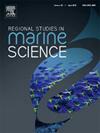印度孟买马诺里河鱼类的营养行会结构、摄食重叠和饮食相关的人为颗粒
IF 2.4
4区 环境科学与生态学
Q3 ECOLOGY
引用次数: 0
摘要
该研究在8个月的时间里调查了印度孟买马诺里溪25个科的38种鱼类的食物和摄食习惯以及人为颗粒的存在。对632只幼鱼的肠道内容物进行了分析。日粮宽度(Bi)在0.25 ~ 0.92之间变化,表现出多面手的趋势。确定了6个生态行会,其中最重要的是海洋河口机会主义者(MMO)。通过SIMPROF检验和聚类树形图分析,形成了11个营养行会,其中以食用虫类(14种)为最大行会。亚纲是最重要的猎物,占68.4% %。行会内部存在显著的饮食重叠(α≥0.6),但行会之间不存在显著的饮食重叠。鱼类肠道中的人为颗粒污染水平显著。在属于8个营养行会的研究物种中,52.6% %被发现在其肠道中有颗粒,从65.6% %的dussumicoilia到6.52% %的Johnius belangerii。这项研究将有助于全面了解食物网、营养动力学及其与人为颗粒摄入的关系,从而支持这一重要沿海生态系统的管理和保护。本文章由计算机程序翻译,如有差异,请以英文原文为准。
Trophic guild structure, feeding overlap and diet-associated anthropogenic particles in the fishes of Manori Creek, Mumbai, India
The study examined the food and feeding habits and the presence of anthropogenic particles of 38 fish species from 25 families in Manori Creek, Mumbai, India, over an eight-month period. Gut contents of 632 individuals, primarily juveniles, were analysed. The diet breadth (Bi) varied from 0.25 to 0.92, indicating generalist tendencies. Six ecological guilds were identified, with Marine Estuarine Opportunists (MMO) being the most significant. Eleven trophic guilds were formed using SIMPROF test and cluster dendrogram, with Acetes feeders (14 species) being the largest guild. Acetes spp. was the most important prey, present in 68.4 % of species. Significant diet overlap occurred within guilds (α ≥ 0.6) but not between different guilds. Anthropogenic particles in fish gut highlighted significant pollution levels. 52.6 % of the studied species belonging to eight trophic guilds were found to have the particles in their gut, ranging from 65.6 % of Coilia dussumieri to 6.52 % of Johnius belangerii. The research will contribute to a comprehensive understanding of the food web, trophic dynamics, and their relationship with the ingestion of anthropogenic particles, thereby supporting the management and conservation of this important coastal ecosystem.
求助全文
通过发布文献求助,成功后即可免费获取论文全文。
去求助
来源期刊

Regional Studies in Marine Science
Agricultural and Biological Sciences-Ecology, Evolution, Behavior and Systematics
CiteScore
3.90
自引率
4.80%
发文量
336
审稿时长
69 days
期刊介绍:
REGIONAL STUDIES IN MARINE SCIENCE will publish scientifically sound papers on regional aspects of maritime and marine resources in estuaries, coastal zones, continental shelf, the seas and oceans.
 求助内容:
求助内容: 应助结果提醒方式:
应助结果提醒方式:


